This last December, I had a chance to swing by the Solis Game Studios booth at PAX Unplugged, excited to see what new games they had. Our crew had really enjoyed their games like Space Lion, and the company is known for having good, snappy dueling games that focus on card play. With that in mind, it was time to dive into their longest running franchise: Pocket Paragons. It's newest set —well, technically this set is called The Massive-Verse Fighting Card Game, powered by Pocket Paragons—adds eight heroes and villains to the dueling card game’s already eclectic lineup. I was excited to give it a shot and see what just one standalone box could do.
If you’re not familiar with the Massive-Verse (I sure wasn’t), it’s a shared universe of superhero comics consisting of Radiant Black and its spinoffs. In this world, average people tap into the powers of alien beings called Radiants, turning into colorful superheroes to protect the world… sometimes from the Radiants themselves. Picture Invincible with a splash of Power Rangers flair and you’ll be on the right track. The Massive-Verse is spearheaded by comics industry veteran Kyle Higgins and published by Image Comics. While I didn't know anything about the comics going into this, the card art was great, and it didn't keep me from enjoying my time with the game.
Meanwhile, Pocket Paragons itself is a light dueling card game. It pits characters from various universes against each other in 1-on-1 fights to see who’s the last one standing. Previous sets include characters from Solis’s own Space Lion, the combining robots of AEGIS, and the high fantasy… heroes?… of Penny Arcade’s Acquisitions Incorporated, among others. If this sounds a lot like my old favorite Exceed Fighting System, it absolutely is, except this game is about one-third the size.
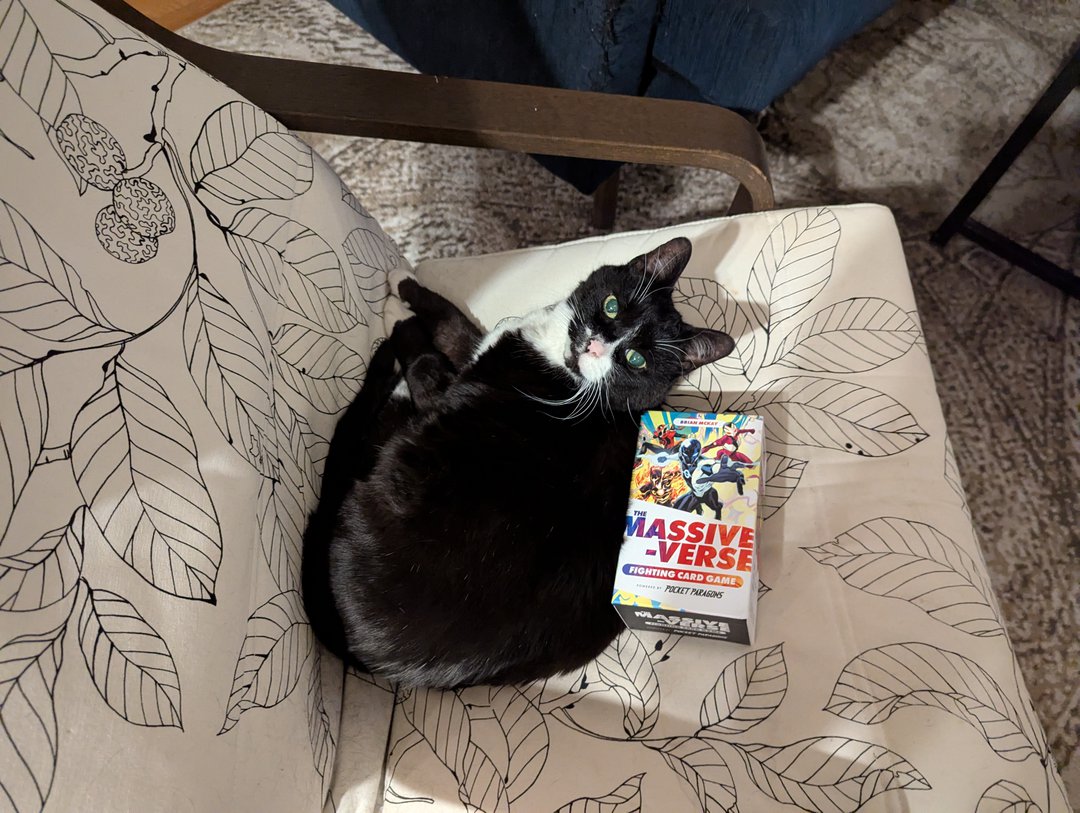
Which brings us to the age-old question:
What’s in the Box?
The Massive-Verse Fighting Card Game powered by Pocket Paragons—which I’ll be calling Massive-Verse FCG from now on, because jeez—comes with eight Paragons (characters), two life and energy trackers, and a rulebook. In short, it’s everything you need to start super-punching each other.
Digging a bit further, those eight decks each represent a hero or villain from the Massive-Verse, like the gravity-manipulating Radiant Black and The Dead Lucky, who controls machines and apparently sees ghosts, for some reason? And if you’re wondering how eight full decks can fit into one small box, it’s because each deck only has nine cards in it: a character card and eight ability cards.
The decks are small, but these characters have a lot of… uh, character, with their powers and personalities reflected in their ability cards. My favorite example is Inferno Girl Red, who’s extremely powerful when she’s winning and feeling confident, but weakens and crumbles under pressure.
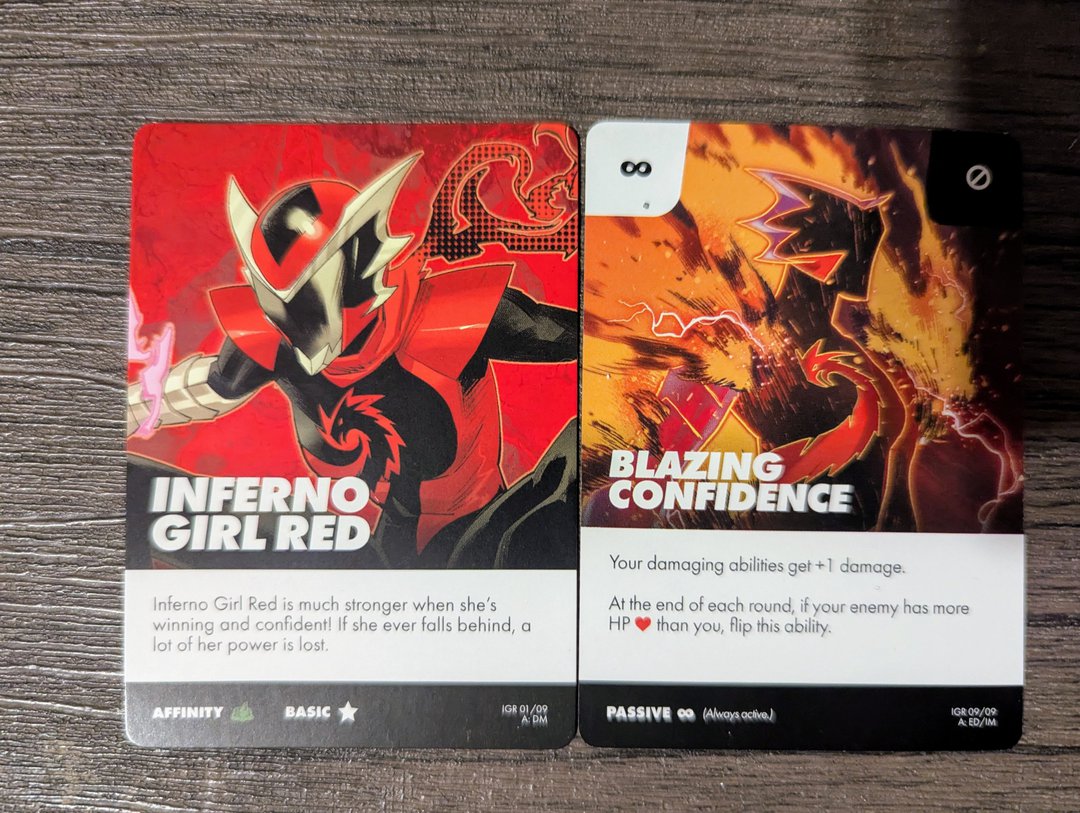
Inferno Girl Red: If winning, win more.
Appropriately, Red’s passive ability in the FCG makes her deal extra damage if her HP is higher than her opponent’s. Several of her cards also have extra effects that go off if she successfully counters her opponent’s attack (more on countering shortly). On the other hand, if she messes up and her Ultimate ability doesn’t hit, she loses it for the rest of the game.
How to Play
This will be a pretty short section because the Massive-Verse FCG rulebook is, no exaggeration, the smallest I’ve ever seen.
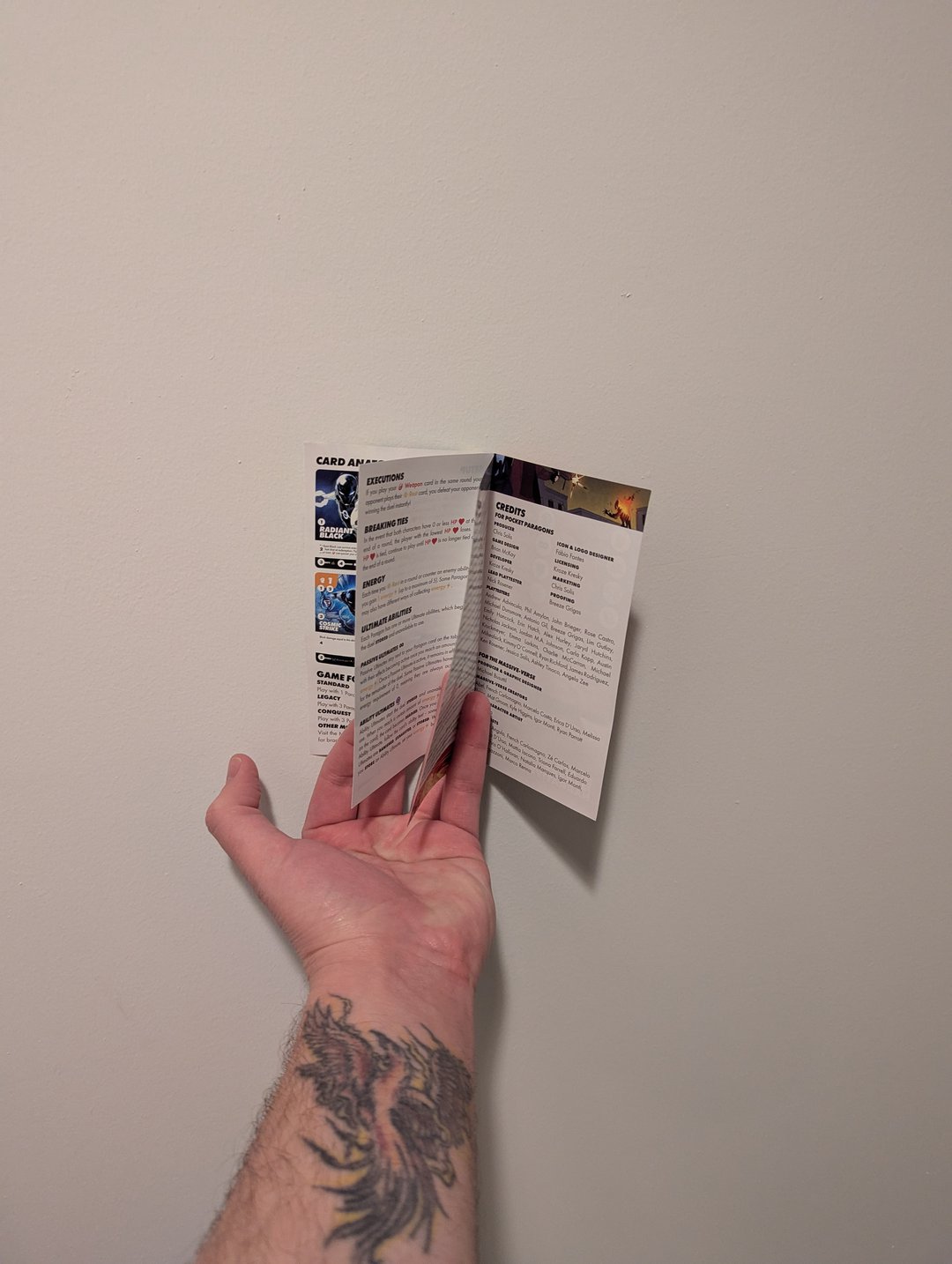
Just five pages, and one of those is the glossary.
Setup is extremely simple. Just put your Paragon and their passive ability into play, put their ultimate ability off to the side for later, set your HP to 10 and your Energy to zero, and you’re all set. The other six cards go into your hand, where you can use them to try to take down your opponent.
The rules are also very simple. A game of Massive-Verse FCG consists of a series of rounds where both people play one card, and… that’s it. You and your opponent set your cards facedown, reveal them once you’re both ready, resolve damage and any other effects, then discard those cards and move on to the next round.
The game ends once one Paragon is defeated, which usually takes 5-10 minutes. If you’re looking to kill more time than that, you can play a best-of-three match or try one of the alternate game formats, where you use three Paragons instead of just one.
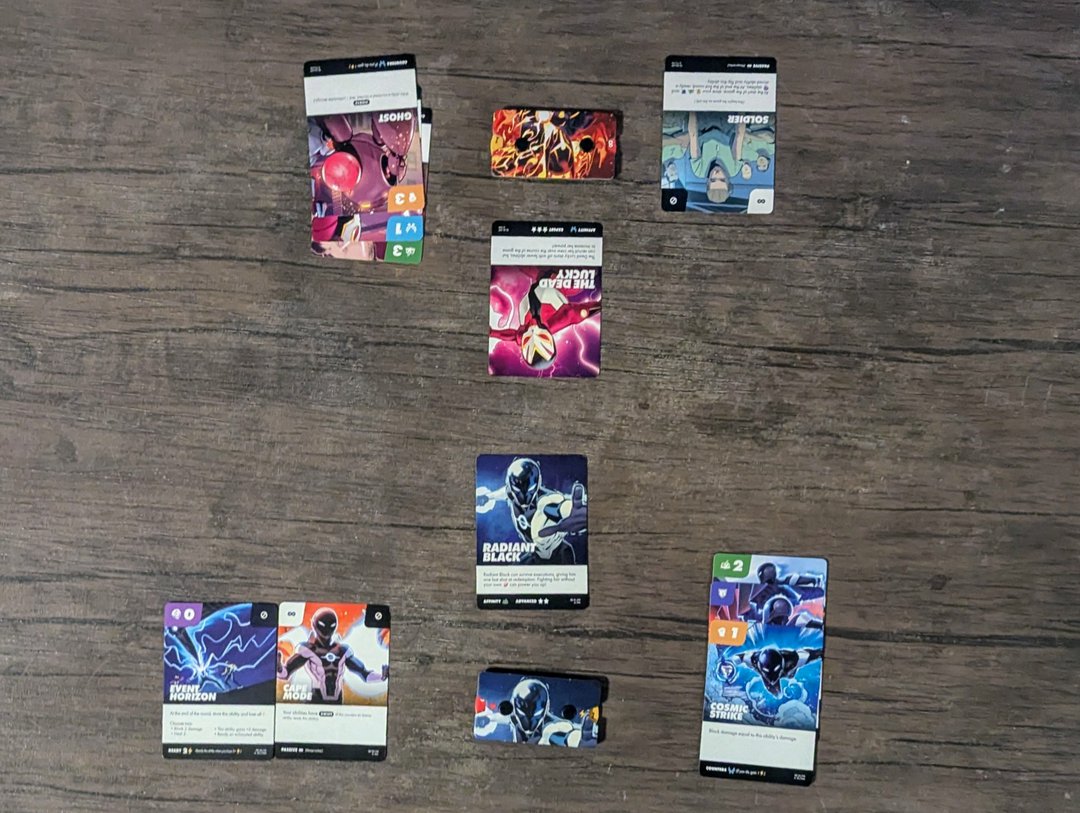
Legacy Mode (where each new Paragon “inherits” one card from the previous fighter) opens up a lot of interesting possibilities.
How to Win: Card Types and Counters
Massive-Verse FCG is certainly easy to play, but playing well is a bit harder than it seems, mostly because of the Counter mechanic. But first, we need to quickly review the eight card types.
- Strength: Counters Agility
- Agility: Counters Intelligence
- Intelligence: Counters Strength
- Defend: Blocks all incoming damage
- Passive: An ongoing effect that activates once you have a certain amount of Energy
- Ultimate: A powerful ability that requires Energy to use
- Rest: Returns all discarded cards to your hand and gives you one Energy
- Weapon: Counters Rest
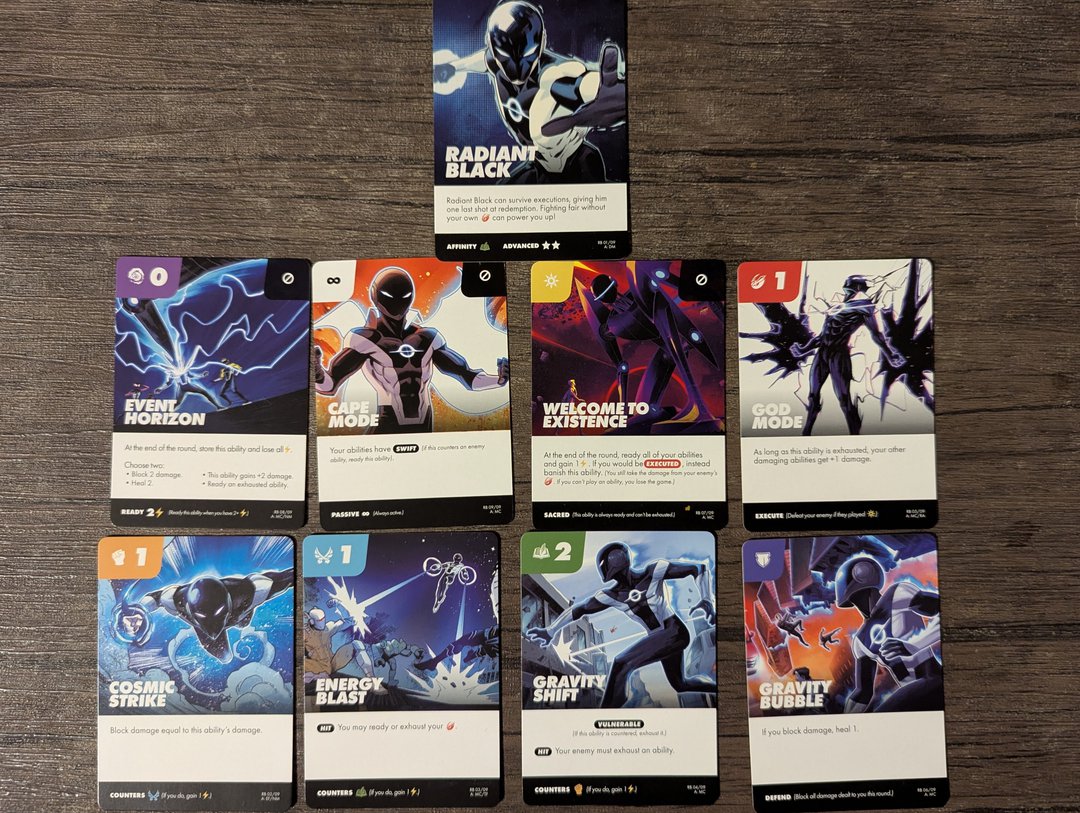
Each Paragon comes with one card of each type. That, plus their character card, makes up their nine card deck.
As you can see, there’s a Rock-Paper-Scissors sort of setup where certain ability types counter others. What does that actually mean? If a card gets countered, it just plain doesn’t work: no damage, no effects, nothing (though it does go back to the hand instead of getting discarded, so that’s a bit of a consolation prize).
A successful counter also gives you Energy, which is much more efficient than relying on your Rest card. Basically, effective countering is the backbone of Massive-Verse FCG, so you’ll quickly realize that this game relies on deduction just as much as strategy.
Oh, one more thing: the “counter” on Weapon cards works a bit differently from the others. It’s called Execute, and instead of bouncing back the opponent’s Rest card, you just win. Because killing your opponent in their sleep is what heroes do! Seriously though, it's very satisfying when you outwit your opponent and just take the game in one fell swoop. Best of all, because rounds are so fast, it's hard to be too mad when someone manages to pull it off on you.
Closing Thoughts
First, let’s get this out of the way: Massive-Verse FCG is a good game, but it’s not the right game for me. I can’t help but compare it to Exceed, and I find that I can’t sink my teeth into Massive-Verse’s strategy in the same way—it’s a little too bare-bones for my taste. So if you, like me, grew up playing heavier card games like Magic and Netrunner, you’ll probably find that this doesn’t quite scratch the same itch.
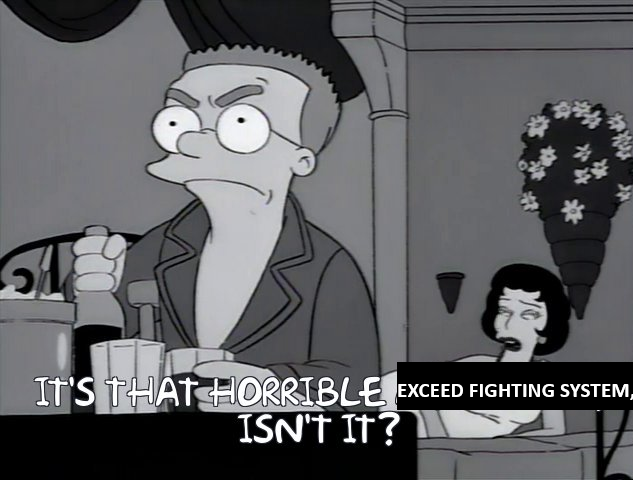
I want to love it, but my heart belongs to other card games.
I want to emphasize that I am not, in any way, bashing Massive-Verse FCG (or Pocket Paragons as a whole). It’s very easy to learn, mechanically solid, and hugely replayable—overall, you get an impressive amount of game considering it’s just nine cards per character. It would be perfect as an introduction to this style of card game or as a quick palate cleanser between heavier games. Heck, if you’re really into the social deduction side of card games, Massive-Verse FCG might become a new favorite! It's just not my favorite.
The Massive-Verse Fighting Card Game is available now on Solis’s website, and well worth the price at just $25. Or, if you’re sold on the game but not the theme, you can take a look at the rest of the Pocket Paragons line and see if a different box catches your eye. It's one of the best things about the Pocket Paragon system - its easy to grab another set of characters, mix them all up, and keep on playing.
With all that said, I'd say this game is worth trying out. Maybe it won't be your favorite, but it's quick to pick up, light enough to stick in your game bag no matter what, and very easy to quickly play round after round with friends.